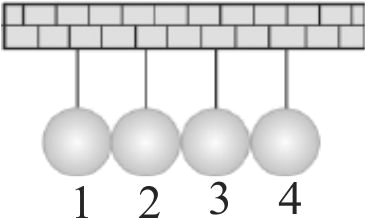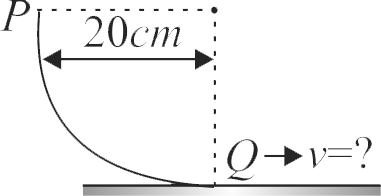355282
Assertion :
A particle strikes head-on with another stationary particle (of same mass) such that the first particle comes to rest after collision. The collision should necessarily be elastic.
Reason :
In elastic collision, there is a loss of momentum of the system of the particles.
355283
In the given figure four identical spheres of equal mass \(m\) are suspended by wires of equal length \(l_{0}\), so that all spheres are almost touching to one other. If the sphere 1 is released from the horizontal position and all collisions are elastic, the velocity of sphere 4 just after collision is
355284
As per the given figure, a small ball \(P\) slides down the quadrant of a circle and hits the other ball \(Q\) of equal mass which is initially at rest. Neglecting the effect of friction and assume the collision to be elastic, the velocity of ball \(Q\) after collision will be (\(g = 10\;m{s^{ - 2}}\))
355282
Assertion :
A particle strikes head-on with another stationary particle (of same mass) such that the first particle comes to rest after collision. The collision should necessarily be elastic.
Reason :
In elastic collision, there is a loss of momentum of the system of the particles.
355283
In the given figure four identical spheres of equal mass \(m\) are suspended by wires of equal length \(l_{0}\), so that all spheres are almost touching to one other. If the sphere 1 is released from the horizontal position and all collisions are elastic, the velocity of sphere 4 just after collision is
355284
As per the given figure, a small ball \(P\) slides down the quadrant of a circle and hits the other ball \(Q\) of equal mass which is initially at rest. Neglecting the effect of friction and assume the collision to be elastic, the velocity of ball \(Q\) after collision will be (\(g = 10\;m{s^{ - 2}}\))
355282
Assertion :
A particle strikes head-on with another stationary particle (of same mass) such that the first particle comes to rest after collision. The collision should necessarily be elastic.
Reason :
In elastic collision, there is a loss of momentum of the system of the particles.
355283
In the given figure four identical spheres of equal mass \(m\) are suspended by wires of equal length \(l_{0}\), so that all spheres are almost touching to one other. If the sphere 1 is released from the horizontal position and all collisions are elastic, the velocity of sphere 4 just after collision is
355284
As per the given figure, a small ball \(P\) slides down the quadrant of a circle and hits the other ball \(Q\) of equal mass which is initially at rest. Neglecting the effect of friction and assume the collision to be elastic, the velocity of ball \(Q\) after collision will be (\(g = 10\;m{s^{ - 2}}\))
355282
Assertion :
A particle strikes head-on with another stationary particle (of same mass) such that the first particle comes to rest after collision. The collision should necessarily be elastic.
Reason :
In elastic collision, there is a loss of momentum of the system of the particles.
355283
In the given figure four identical spheres of equal mass \(m\) are suspended by wires of equal length \(l_{0}\), so that all spheres are almost touching to one other. If the sphere 1 is released from the horizontal position and all collisions are elastic, the velocity of sphere 4 just after collision is
355284
As per the given figure, a small ball \(P\) slides down the quadrant of a circle and hits the other ball \(Q\) of equal mass which is initially at rest. Neglecting the effect of friction and assume the collision to be elastic, the velocity of ball \(Q\) after collision will be (\(g = 10\;m{s^{ - 2}}\))

